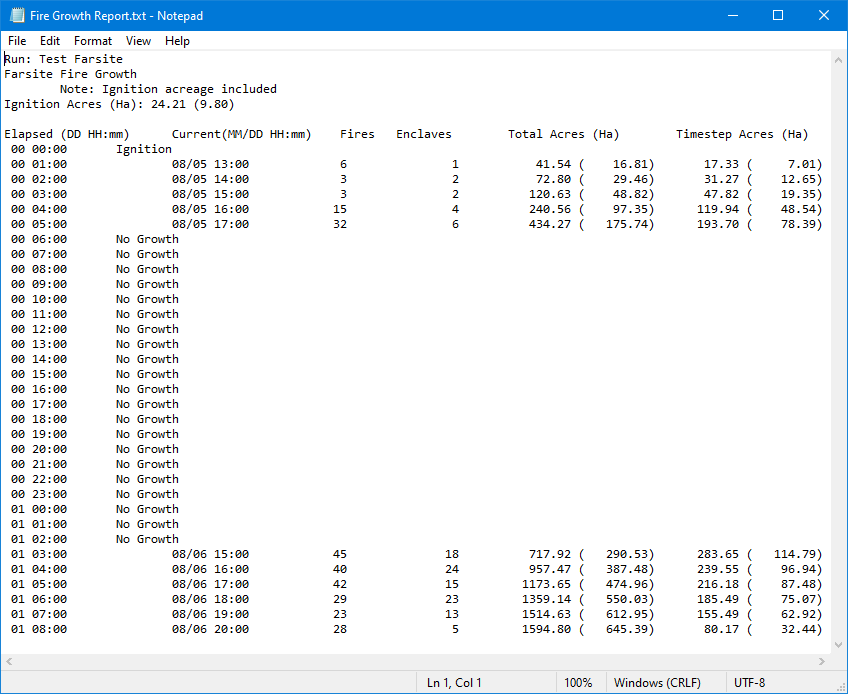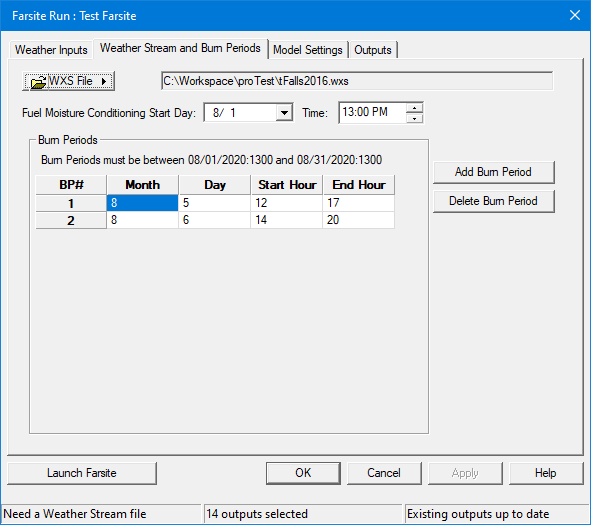
The Fire Growth Report is an additional output included with every completed Farsite simulation as text output. It is generated at the end of the run and will show up in the run Tree.
The file contains information on fire growth for each time step and burn period throughout the simulation. Time intervals and periods of reported growth are determined by the Time Step and Burn Periods parameters on the Model Settings tab.
The following example is for a Farsite simulation with a 60 minute time step and two burn periods.

A header lists the run name and size of the ignition, then Rows/Columns show,
Elapsed Time (DD HH:mm) - Total Running simulation time in days and hours including periods of No Growth. Time increment is based on the Time Step value on the Model Settings tab.
Current (MM/DD HH:mm) - Current simulation date and time based on the end of the burn periods. Time increment is the Time Step value on the Model Settings tab. Times outside the burn periods are labeled "No Growth".
Fires - Number of individual fires being tracked in each time step.
Enclaves - Number of non-burning areas being tracked within each time step. Acres are not reported.
Total Acres - Cumulative total acres reported by time step. The reported value includes the ignition acreage if a polygon ignition is used. Total hectares are also shown in parentheses.
Timestep Acres - Actual acres of fire growth by each specific timestep does not include the ignition acreage. Timestep hectares are also shown in parentheses.
In the above Fire Growth Report (FGR) example a polygon ignition file of 24.21 acres was used, the time step was at 60 minutes, two Burn Periods were used, and ignition time was 0800 on 8/5 as shown below for a total elapsed simulation time of 32 hours.

The first row in the Elapsed column of 00:00 shows the Ignition and no other information.

The second row at 00 01:00 (1-hour since ignition) shows the current simulation date and time of 08/05 1300 hours. This is the first reported perimeter. The Total Acres is 41.54 which includes the size of the ignition perimeter (24.21 acres). The Timestep Acres is the Total Acres minus the Ignition Acres, equaling 17.33 acres.
The third row at 00 02:00 (2-hours since ignition) shows the current simulation date and time of 08/05 1400 hours. This is the second reported perimeter. The current Total Acres is 72.80 which includes the acres of the ignition perimeter (24.21). The Timestep Acres is the current Total Acres (72.80) minus the previous time step Total Acres (41.54) equaling 31.27 acres. Notice the occasional small rounding error.
The last reported elapsed timestep in the first burn period is at 00 5:00 and shows the current simulation date and time of 08/05 1700 hours which corresponds to the End Hour in the first Burn Period settings. The reported cumulative Total Acres at this timestep is 434.27 acres (includes the ignition polygon acres). The actual fire growth during this time step was 193.70 acres.
The actual total fire size at the end of the first Burn Period (08/05 17:00) can be calculated in two ways,
The "No Growth" time steps are outside of the set Burn Periods days and times. During these time frames active fire growth does not occur.
The second Burn Period begins on 08/06 at 1500 hours. The elapsed time is now 01 03:00, 1-day [24-hours plus 3 hours = 27 hours]. The reported Total Acres at the first time step in the second burn period is 717.92 which includes the ignition acres. This is the previously reported burn period Total Acres plus the current reported Timestep Acres (434.27 + 283.65 = 717.92 acres).

The reported acres for each specific time step is determined for the second burn period as described previously. At the end of the second burn period (08/06 20:00) the Total Acres is 1594.80 acres. Because Total Acres is cumulative this represents the final fire size at the end of the simulation (both burn periods and ignition acres). To get the final fire size without the ignition polygon acres you need to subtract the ignition acres (1594.80 - 24.21 = 1570.59 acres).
The final simulated fire size and total acres by burn period can also be obtained by summing each burn period’s Timestep Acres. For example: